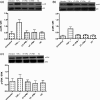Purified IgG from patients with obstetric but not IgG from non-obstetric antiphospholipid syndrome inhibit trophoblast invasion
- PMID: 25469631
- PMCID: PMC4409084
- DOI: 10.1111/aji.12341
Purified IgG from patients with obstetric but not IgG from non-obstetric antiphospholipid syndrome inhibit trophoblast invasion
Abstract
Problem: Some patients with antiphospholipid syndrome (APS) suffer pregnancy morbidity (PM) but not vascular thrombosis (VT), whilst others suffer VT only. Therefore, we compared the effects of IgG from VT+/PM- and VT-/PM+ subjects on human first-trimester trophoblast (HTR8) cells.
Method of study: HTR-8 cells were incubated with APS VT+/PM-, APS VT-/PM+ or healthy control (HC) IgG. We measured trophoblast invasion by cell invasion assay; mRNA expression of TLR4 and adaptor proteins; phosphorylation of p38 MAPK, NFκB and ERK; and expression of interleukin (IL)-8 and IL-6.
Results: VT-/PM+ IgG, but not VT+/PM- IgG significantly reduced HTR-8 invasion. The effects on invasion were blocked by TLR-4 inhibition. Neither VT+/PM- nor VT-/PM+ IgG altered MyD88 mRNA expression, phosphorylation of signalling molecules or cytokine expression.
Conclusions: VT-/PM+ IgG exert functionally relevant effects on human trophoblast cells but VT+/PM- IgG do not.
Keywords: Antiphospholipid; TLR4; obstetric; trophoblast.
© 2014 The Authors American Journal of Reproductive Immunology Published by John Wiley & Sons Ltd.
Figures




References
-
- Cervera R, Piette JC, Font J, Khamashta MA, Shoenfeld Y, Camps MT, Jacobsen S, Lakos G, Tincani A, Kontopoulou-Griva I, Galeazzi M, Meroni PL, Derksen RH, de Groot PG, Gromnica-Ihle E, Baleva M, Mosca M, Bombardieri S, Houssiau F, Gris JC, Quere I, Hachulla E, Vasconcelos C, Roch B, Fernandez-Nebro A, Boffa MC, Hughes GR, Ingelmo M. Antiphospholipid syndrome: clinical and immunologic manifestations and patterns of disease expression in a cohort of 1,000 patients. Arthritis Rheum. 2002;46:1019–1027. - PubMed
-
- Rai RS. Antiphospholipid syndrome and recurrent miscarriage. J Postgrad Med. 2002;48:3–4. - PubMed
-
- Backos M, Rai R, Baxter N, Chilcott IT, Cohen H, Regan L. Pregnancy complications in women with recurrent miscarriage associated with antiphospholipid antibodies treated with low dose aspirin and heparin. Br J Obstet Gynaecol. 1999;106:102–107. - PubMed
-
- Sebire NJ, Fox H, Backos M, Rai R, Paterson C, Regan L. Defective endovascular trophoblast invasion in primary antiphospholipid antibody syndrome-associated early pregnancy failure. Hum Reprod. 2002;17:1067–1071. - PubMed
-
- Sebire NJ, Backos M, El Gaddal S, Goldin RD, Regan L. Placental pathology, antiphospholipid antibodies, and pregnancy outcome in recurrent miscarriage patients. Obstet Gynecol. 2003;101:258–263. - PubMed
Publication types
MeSH terms
Substances
Grants and funding
LinkOut - more resources
Full Text Sources
Other Literature Sources
Medical
Molecular Biology Databases
Research Materials
Miscellaneous

